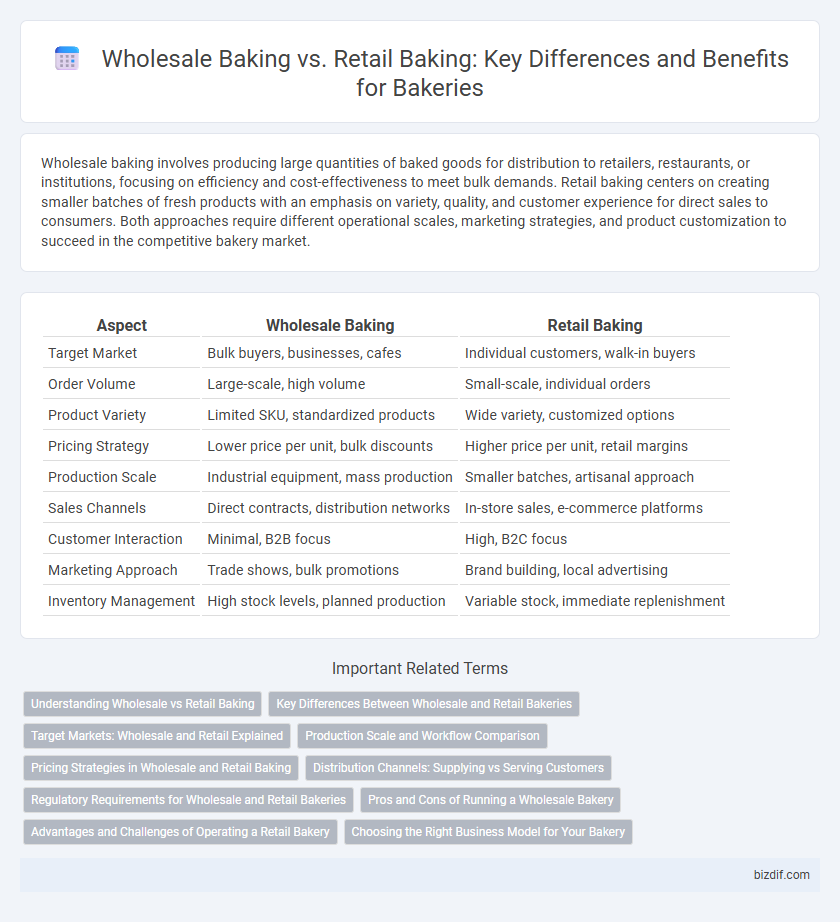Wholesale baking involves producing large quantities of baked goods for distribution to retailers, restaurants, or institutions, focusing on efficiency and cost-effectiveness to meet bulk demands. Retail baking centers on creating smaller batches of fresh products with an emphasis on variety, quality, and customer experience for direct sales to consumers. Both approaches require different operational scales, marketing strategies, and product customization to succeed in the competitive bakery market.
Table of Comparison
| Aspect | Wholesale Baking | Retail Baking |
|---|---|---|
| Target Market | Bulk buyers, businesses, cafes | Individual customers, walk-in buyers |
| Order Volume | Large-scale, high volume | Small-scale, individual orders |
| Product Variety | Limited SKU, standardized products | Wide variety, customized options |
| Pricing Strategy | Lower price per unit, bulk discounts | Higher price per unit, retail margins |
| Production Scale | Industrial equipment, mass production | Smaller batches, artisanal approach |
| Sales Channels | Direct contracts, distribution networks | In-store sales, e-commerce platforms |
| Customer Interaction | Minimal, B2B focus | High, B2C focus |
| Marketing Approach | Trade shows, bulk promotions | Brand building, local advertising |
| Inventory Management | High stock levels, planned production | Variable stock, immediate replenishment |
Understanding Wholesale vs Retail Baking
Wholesale baking involves producing large quantities of baked goods primarily for businesses, such as grocery stores, cafes, and restaurants, emphasizing consistent quality and bulk packaging. Retail baking focuses on directly selling freshly baked items to individual customers, often offering a diverse menu with customizable options to cater to local tastes and preferences. Understanding the distinction aids bakers in optimizing production, pricing strategies, and marketing efforts for targeted customer segments.
Key Differences Between Wholesale and Retail Bakeries
Wholesale bakeries focus on producing large quantities of baked goods to supply restaurants, grocery stores, and other businesses, emphasizing scale and efficiency. Retail bakeries prioritize customer experience, offering freshly baked products directly to consumers, often with a variety of artisanal and customized options. Key differences include order volume, target market, packaging requirements, and pricing strategies tailored to business clients versus individual customers.
Target Markets: Wholesale and Retail Explained
Wholesale baking targets bulk buyers such as grocery stores, restaurants, and caterers seeking large quantities of baked goods at lower prices. Retail baking focuses on individual customers or small groups who purchase products directly from bakeries for immediate consumption or special occasions. Understanding these distinct target markets enables bakeries to tailor production, pricing, and marketing strategies effectively.
Production Scale and Workflow Comparison
Wholesale baking involves large-scale production with automated processes designed to produce high volumes of baked goods efficiently, catering primarily to businesses such as restaurants, grocery stores, and cafes. Retail baking focuses on smaller batches with more attention to artisanal quality and customization, directly serving individual customers in a bakery shop setting. Workflow in wholesale requires streamlined, repetitive tasks optimized for speed and consistency, whereas retail baking emphasizes flexibility and craftsmanship in product variety and presentation.
Pricing Strategies in Wholesale and Retail Baking
Wholesale baking pricing strategies prioritize volume-based discounts and lower per-unit costs to attract bulk buyers like restaurants and supermarkets, ensuring competitive rates while maintaining profitability. Retail baking focuses on premium pricing models that highlight product quality, artisanal craftsmanship, and brand value to justify higher prices in individual sales. Both strategies leverage cost management techniques but differ in elasticity sensitivity, with wholesale demanding lower margins offset by larger sales, whereas retail banking capitalizes on consumer experience and impulse purchases.
Distribution Channels: Supplying vs Serving Customers
Wholesale baking emphasizes supplying large quantities of baked goods to businesses, restaurants, and retailers through extensive distribution channels such as distributors and direct delivery services. Retail baking focuses on serving individual customers directly in-store or via online platforms, prioritizing product presentation, customer experience, and personalized service. Efficient distribution channels in wholesale prioritize bulk logistics and timely delivery, while retail channels optimize accessibility and customer engagement.
Regulatory Requirements for Wholesale and Retail Bakeries
Wholesale bakeries must comply with stringent regulatory requirements including FDA food safety standards, Hazard Analysis Critical Control Point (HACCP) plans, and state-level commercial kitchen licenses to ensure safe mass production and distribution. Retail bakeries face regulations targeted at consumer safety such as proper labeling, allergen disclosures, and adherence to local health department inspections for on-site food preparation and sales. Both wholesale and retail operations must maintain rigorous sanitation protocols, employee training in food handling, and compliance with the Food Safety Modernization Act (FSMA) to avoid legal penalties and ensure product quality.
Pros and Cons of Running a Wholesale Bakery
Running a wholesale bakery offers benefits such as higher production volumes, consistent large orders, and reduced marketing costs due to bulk client relationships. However, it presents challenges including lower profit margins per unit, dependency on fewer large clients, and the need for specialized equipment and larger production space. Wholesale baking demands strong supply chain management and robust quality control to maintain product consistency across high quantities.
Advantages and Challenges of Operating a Retail Bakery
Retail baking offers direct customer interaction, enabling bakeries to tailor products to local tastes and receive immediate feedback, which enhances brand loyalty and customer satisfaction. The challenges include managing high overhead costs, such as rent and staffing, and maintaining consistent product quality during peak hours. Retail bakeries also face inventory management difficulties, requiring precise forecasting to minimize waste and meet daily demand.
Choosing the Right Business Model for Your Bakery
Wholesale baking focuses on producing large quantities of baked goods for distribution to retailers, restaurants, and institutions, enabling economies of scale and consistent demand. Retail baking involves direct sales to consumers through storefronts or online platforms, emphasizing product variety, customer experience, and branding. Selecting the right business model depends on factors like target market, production capacity, pricing strategy, and marketing goals to maximize profitability and growth.
Wholesale baking vs Retail baking Infographic

 bizdif.com
bizdif.com